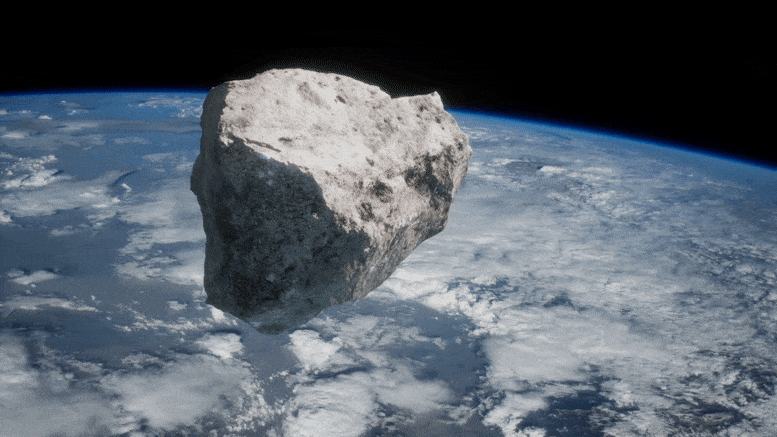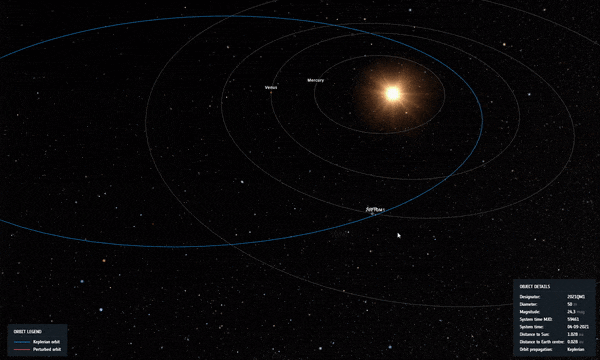
L’astéroïde « 2021 QM1 » a été officiellement retiré de la liste des dangers d’astéroïdes de l’Agence spatiale européenne. Il reste encore 1 377 astéroïdes. (L’impression d’artiste d’un astéroïde se précipitant vers la Terre.)
L’impact est exclu en 2052 alors que l’Agence spatiale européenne (ESA) entame le compte à rebours de la Journée des astéroïdes
Juste à temps pour la Journée mondiale des astéroïdes : une roche spatiale menacée qui figure en tête des listes de risques dans le monde depuis des mois, avec une réelle chance de frapper la Terre le 2 avril 2052. Maintenant, l’équipe des astéroïdes de l’Agence spatiale européenne travaille avec des experts de l’Observatoire de l’Europe du Sud ([{ » attribute= » »>ESO) has officially removed ‘2021 QM1’ from their asteroid risk list, a result of skilled observations and analysis of the faintest asteroid ever observed with one of the most sensitive telescopes ever constructed.
With Asteroid Day Live 2022 set for June 30, we can safely say that the riskiest asteroid known to humankind in the last year will not impact the Earth – at least not for the next century.
What was it like to track this asteroid? Get the full story in ESA’s fascinating behind-the-scenes look at how European experts handle asteroid risks in the official countdown to Asteroid Day live on June 30, airing at 10:25 CEST on AsteroidDay.org and via ESA WebTV.

Asteroid 2021 QM1, once thought to have a chance of impacting Earth in 2052, was spotted passing through a region of the sky with the Milky Way just behind it. The small, faint, receding asteroid had to be found against a backdrop of thousands of stars, with red crosses indicating the path of the object. Credit: ESO/O. Hainaut
Impact 2052
2021 QM1 was first discovered on August 28, 2021, by the Mount Lemmon Observatory, located north of Tucson, Arizona. At the beginning, nothing stood out as unusual about the discovery – about a dozen new near-Earth asteroids are identified every dark night. Routine follow-up observations were subsequently acquired from telescopes around the globe, but these began to tell a more worrying story.
“These early observations gave us more information about the asteroid’s path, which we then projected into the future,” said Richard Moissl, ESA’s Head of Planetary Defense.
“We could see its future paths around the Sun, and in 2052 it could come dangerously close to Earth. The more the asteroid was observed, the greater that risk became.”
Il est important de noter que les calculs orbitaux basés sur seulement quelques nuits d’observations sont sujets à une certaine incertitude, c’est pourquoi les astéroïdes sont souvent ajoutés à la liste des risques de l’ESA peu de temps après leur découverte et ensuite supprimés une fois que des données supplémentaires sont collectées, et des incertitudes diminuer la certitude. , et l’astéroïde s’est avéré sûr. A cette occasion, cela n’a pas été possible.
Un malheureux alignement cosmique
Alors que le danger semblait augmenter, un alignement cosmique parfait s’est produit : la trajectoire de l’astéroïde l’a rapproché du Soleil vu de la Terre, rendu impossible à voir pendant plusieurs mois par la brillante lueur de notre étoile hôte.

En orbite autour de 2021 QM1 alors qu’il passe près du Soleil dans le ciel vu de la Terre, peu de temps après sa découverte. Crédit : ESA
« Nous n’avions qu’à attendre », a expliqué Marco Micheli, astronome au Centre de coordination des objets géocroiseurs (NEOCC) de l’Agence spatiale européenne.
« Mais pour arrêter les choses, nous avons appris que 2021 QM1 s’éloignait également de la Terre sur son orbite actuelle, ce qui signifie qu’au moment où il serait sorti de l’éblouissement du soleil, il pourrait être trop faible pour être détecté. »
Pendant qu’ils attendaient, ils se préparaient.
Accès prioritaire à l’un des télescopes les plus puissants sur Terre
Observatoire européen austral Très grand télescope (VLT) C’était prêt et prêt. Une fois que l’astéroïde de 50 mètres de haut s’éloignera de la lumière du soleil – et que les conditions météorologiques le permettront – le VLT de l’ESO focalisera son miroir de 8 mètres sur les roches en voie de disparition.

Un amas lunaire passionnant derrière le Very Large Telescope (VLT) de l’ESO, au Chili. Lorsque la lune se couche, le soleil est sur le point de se lever à l’horizon opposé. Le Very Large Telescope (VLT) a déjà fermé les yeux après une longue nuit d’observations, les opérateurs du télescope et les astronomes dorment tandis que les techniciens, ingénieurs et astronomes de jour se réveillent pour une nouvelle journée de travail. Les opérations ne s’arrêtent jamais à l’observatoire astronomique le plus productif au monde. Crédit : G.Gillet / ESO
« Nous avions une courte fenêtre pour observer notre périlleux astéroïde », a expliqué Olivier Hainaut, astronome à l’ESO.
« Pour aggraver les choses, il traversait une zone du ciel avec[{ » attribute= » »>Milky Way just behind. Our small, faint, receding asteroid would have to be found against a backdrop of thousands of stars. These would turn out to be some of the trickiest asteroid observations we have ever made”.
Faintest asteroid ever observed
Over the night of May 24, ESO’s VLT took a series of new images. The data arrived and Olivier and Marco began to process them, stacking subsequent observations on top of each other and removing the background stars: it took some time.

ESO’s Very Large Telescope captures 2021 QM1 which for months topped risk lists around the globe. This pivotal sighting ruled out Earth impact in the year 2052. Over the night of May 24, the European Southern Observatory’s Very Large Telescope took a series of images of an asteroid that had topped risk lists around the globe for months. These images were some of the trickiest asteroid experts had taken, as the faint asteroid 2021 QM1 receded from view against a very starry backdrop. A series of images were processed, stacked on top of each other and stars were removed, revealing the faintest asteroid observed. Credit: ESA
The result? A positive detection of the faintest asteroid ever observed. With a magnitude of 27 on the scale used by astronomers to describe the brightness of objects in the sky, 2021 QM1 was 250 million times fainter than the faintest stars visible to the naked eye from a dark spot. (In this astronomical scale of visible magnitudes, the brighter an object appears the lower the value of its magnitude, while the brightest objects reach negative values, e.g. the Sun is magnitude -27).
Olivier was certain this small blur was in fact an asteroid, and Marco was certain that given its location, it was our asteroid.
Safe at last?
With these new observations, our risky asteroid’s path was refined, ruling out an impact in 2052, and 2021 QM1 was removed from ESA’s risk list. Another 1,377 remain.

The position of each asteroid at 12:00 CEST on June 13, 2022, is plotted. Each asteroid is a segment representing its motion over 10 days. Inner bodies move faster around the Sun (yellow circle at the center). Blue represents the inner part of the Solar System, where the Near Earth Asteroids, Mars crossers, and terrestrial planets are. The Main Belt, between Mars and Jupiter, is green. The two orange ‘clouds’ correspond to the Trojan asteroids of Jupiter. Credit: © ESA/Gaia/DPAC; CC BY-SA 3.0 IGO, Acknowledgments: P. Tanga (Observatoire de la Côte d’Azur)
More than one million asteroids have been discovered in the Solar System, almost 30 000 of which pass near Earth, with many more expected to be out there. ESA’s Planetary Defence Office, NEOCC and astronomers around the globe are looking up to keep us safe, working together to ensure we know well in advance if an asteroid is discovered on a collision course.
Watch Asteroid Day Live
How worried are the world’s asteroid experts? How did it feel to track humankind’s most risky asteroid? Get the full story in ESA’s 30-minute program counting down to Asteroid Day live on June 30, airing at 10:25 CEST on AsteroidDay.org and on ESA WebTV.

Fallen trees at Tunguska, Imperial Russia, seen in 1929, 15 km from epicenter of the aerial blast site, caused by the explosion of a meteor in 1908. Credit: Photo N. A. Setrukov, 1928
Asteroid Day is the United Nations-sanctioned day of public awareness of the risks of asteroid impacts, held annually on June 30. This year sees its return to Luxembourg for an in-person event following two years of living entirely in the virtual realm. Asteroid experts from ESA, from across Europe and worldwide will converge on the city to take part in a packed four-hour live program of panels and one-on-one interviews.

« Drogué des réseaux sociaux. Explorateur d’une humilité exaspérante. Nerd du café. Amical résolveur de problèmes. Évangéliste culinaire. Étudiant. »
